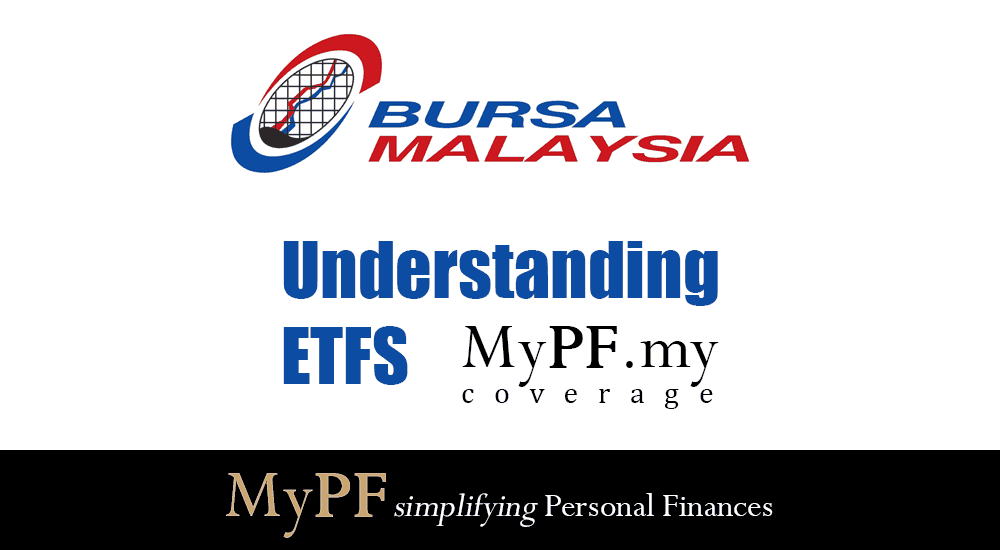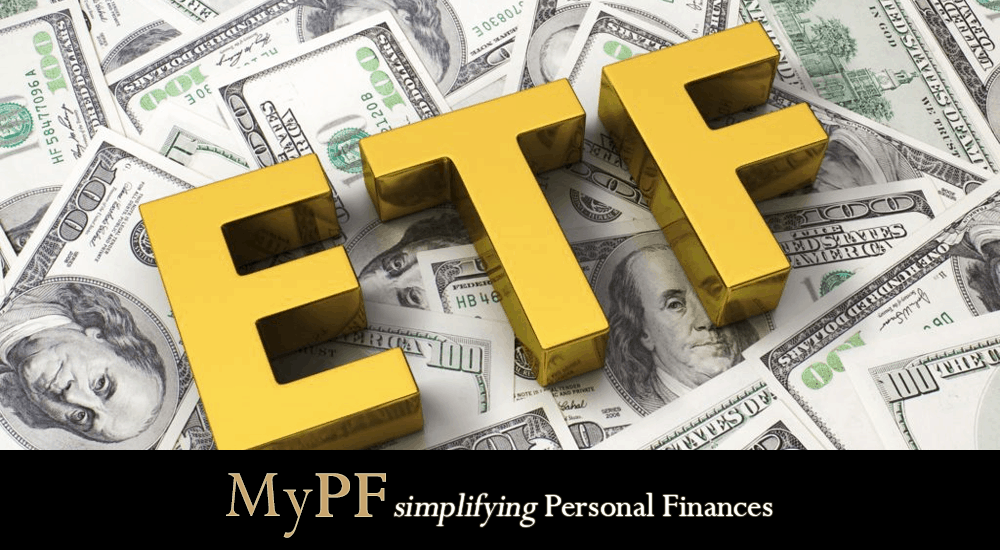Bursa Malaysia is continuing to work on creating awareness on Exchange Traded Funds (ETFs) in Malaysia. As part of Bursa’s effort to educate the public on ETFs, MyPF was invited to attend a workshop covering understanding ETFs, different types of ETFs and their main features, the benefits and risks of buying an ETF, misconceptions about ETFs, and portfolio construction using ETFs.

Contents
Understanding ETFs
An Introduction to ETFs
- ETFs are index trackers.
- Buying a ETF gives you a basket of different equities, bonds, etc.
- A key advantage of ETF is low cost and low cost brokerage fees (as low as 0.1% for bond ETFs).
- An added incentive is stamp duty waived (until Dec 31, 2019).
Benefit of Investing in ETFs
- Cost effective with lower cost of ownership and lower transaction costs with lower portfolio turnover.
- Access to different asset classes and investment assets (diversification).
- Better transparency as entire portfolio is disclosed daily.
- ETFs allow for intraday trading, hedging, and leveraging strategies.
ETF vs UT
- Investors usually expect UT funds to have a better performance versus the underlying index.
- However, an ETF tracks but does not intend to outperform the index.
- ETFs often have lower costs as well for buy-sell transactions.
- Additionally, ETF units can have buy-sell transactions with someone else on the exchange (and does not need to be back to the fund manager).
ETFs vs Shares
- Both ETFs and shares buy-sells are done through brokerage (CDS) account.
- Another similarity is that both ETF and (selected) shares support intraday trading.
- ETFs are an index or basket of securities while a share is an individual security in a single company.

Photo: Chong Lee Choo, Director of Innovation Lab and Alternative Investment from Affin Hwang Asset Management
Understanding IOPV (aka iNAV)
Indicative Optimised Portfolio Value (IOPV) is an intraday NAV.
IPOV = Intraday NAV
IOPV serves as an approximation tot he NAV to that investors will know the fair value price of the ETF
- IOPV is published online at Bursa Marketplace and refreshed regularly every few seconds.
- IOPV functions to help make sure that investors buy at a fair value (or optimally at a discount to fair value).
- There is the potential of arbitrage which is why it always comes back to the fair value.
Arbitrage: simultaneously buying and selling securities (or other assets) taking advantage of differing prices for the same asset
Bursa Malaysia ETFs
[stock_market_widget type=”table” symbol=”0800EA.KL,0822EA.KL,0823EA.KL,0820EA.KL,0827EA.KL,0821EA.KL,0824EA.KL,0825EA.KL,0826EA.KL,0828EA.KL,0829EA.KL” template=”basic” color=”default” fields=”virtual.name,virtual.symbol,quote.regularMarketPrice,quote.regularMarketChange,quote.regularMarketChangePercent”]
ETF Liquidity
Fund managers appoint market makers to provide liquidity in secondary market. Even when transactions not visible, there are market makers available.
Market Makers’s role: to provide liquidity and bring ETF prices back in line with NAV
How does it work?
- The market makers can buy stocks and Bursa will deliver the stocks to them.
- The market maker can buy underlying shares at lower fair value and add to the ETF at trading price.
- This is done when it’s significant and will move prices thus providing liquidity and pricing will return to fair value.
- When underlying security is not liquid, marker maker may need to increase bid-ask spread, as they are taking on higher risk with an obligation to buyback.
However, the marker makes role is not perfect.
- If there’s a breach, regulators will take action on the market makers as contractually obligated.
- Market makers are required to be present 70% of the time with them but are also allowed to stay out when markets are very volatile.
Types of ETFs
The largest market in the world for ETFs is the US market which has many different themes (i.e. sectors) and different strategies available.
For example, if you are into e-Sports (which is actually a bigger market than movies and music combined), you can invest in a ETF like $NERD in the states.
Example of different strategies including following market weight, or being alternatively weighted.
Alternative Weighted Strategies
- Equal weighted: stock components equally weighted.
Note: This favors smaller companies as gives them equal weightage as larger companies. - Factor tilt: favors stocks which give highest dividend yield.
Factor Investing Strategies: focuses on higher returns and lower volatility
- Yield: focus on yields and dividends.
- Momentum: invest in companies with positive momentum (and may short stocks with negative momentum).
- Value: focus on undervalued stocks based on fundamentals.
- Quality: attempts to select stocks that outperform in return on equity, earnings variability, and debt-to-equity.
- Volatility: includes exposure to volatility without having to buy options.
- Size: tracks large and mid-cap stocks based on market cap inverse.
Leverage and Inversed Strategies
- Leveraged: uses leverage (typically debt) to multiply the returns (and losses) of an index/benchmark.
- Inversed (aka Short ETF): is constructed to return the opposite of an index/benchmark.
ETF Investment Strategies
A few options for ETF investment strategies include full replication, partial replication, synthetic, futures-based, and smart Beta. Each strategy may have a tracking error (difference) with the closest being full replication.
- Full replication copies all (or most) of a particular index.
- Partial replication copies most but not all. Reasons could possibly be that they don’t have access to a particular stock thus requiring a proxy.
- Synthetic is where a ETF buys a derivative where they can go to an investment bank and swap.
- Futures-based uses futures to replicate the index.
- Smart Beta strategy consists both active and passive investing. This is an active strategy replacement and there’s value add with fund management input. ETF manager may have a value bias and the index use certain metrics or calculation to make automatic selection based on rules.
Smart Beta captures factor exposures using a rules-based, systematic approach. It eschews traditional cal-weighted strategy but takes into account factors granular to a company or industry, and/or exhibiting certain behavior or metrics such as earnings growth, dividend yield, momentum, and profitability.
Conclusion
Different ETFs will perform differently depending on the type of ETF and investment strategy. For example, momentum strategies tend to do well in volatile markets but poor performance during market declines. Smart Beta fees on the other hand perform better with good fund management and lower fees compared to other forms of active management, but still may costs more in fees than a fully passive index fund ETF.
Among the various propositions offered to you, if you invested in a very low cost index funds (or ETFs) — where you don’t put the money in at one time, but average in over 10 years — you’ll do better than 90% of people who start investing at the same time.
If you like spending 6-8 hours per week working on investments, do it. If you don’t, then dollar-cost average (DCA) into index funds (of ETFs). This accomplishes diversification across assets and time, two very important things.
Just pick a broad index like the S&P 500. Don’t put your money in all at once; do it over a period of time. ~Warren Buffett
In short, consider investing using a DCA approach in ETFs. While Bursa ETFs is not perfect, it exists as a good option to consider. We look forward to Bursa, financial education platforms, and investors to help shape Bursa ETFs for the benefit of all Malaysian investors into the future.

FAQ
Q: Are there too few Bursa ETFs with only 11 ETFs? Is that sufficient?
Yes. It is a misconception that there are not enough ETFs to construct a portfolio. Digital wealth management (re: robo advisory) is mostly focused on US and global ETFs (and often unhedged). There is a need for local Bursa ETFs. Leveraged, inversed, and futures based ETFs will be soon introduced in Bursa.
Q: Are all ALL ETFs supported by market makers?
All Bursa ETFs are supported by market makers. The actual support depends on the respective market maker.
Q: What are the other reasons market makers will not support the market besides market volatility?
Reasons would be liquidity (though usually won’t be away but instead just increase a wider spread) or primary market creation suspended.
Q: How do market makers report report to Burse if and when they will not be support the market?
Market makers perform their own regular monthly reporting to Bursa.
Q: The buy-sell spread for Bursa ETFs is very poor.
If you have the long term in mind, the spread does not matter that significantly (as it’s following the index). It only really matters if you’re not a trader.
Q: What is the maximum spread that can be set?
Max spread 8 ticks 0.01 (RM3) or 0.005 (below RM3) whereby incentives given to market maker. Else, max spread of 20 ticks set by Bursa.
Q: What are the tax implications of investing in ETFs?
US ETFs subject to withholding tax 30%. Malaysia no capital gains or distribution tax.
Note: Unless you’re an insurance company where there’s a capital gain tax.
Q: How is the comparison between local ETFs directly vs robo advisory investing in ETFs?
Robo advisory have management fees that can range up to 1.50%. If low cost ETFs are picked, the ETF fee is about ~0.2%. If you trade ETFs yourself, it is an even lower brokerage rate and a long term charge of say 2.0% will be defrayed over X years (i.e. 2.0% over 5 years is only 0.4% annually).
Q: How are ETF dividends handled?
Dividends received will be reflected as an increase in the ETF fund NAV. It doesn’t make sense for dividend to be distributed every time an underlying security gives dividend. Dividends are typically distributed annually.
Note: The distribution may not match actual 100% of dividends. SC regulation stated that dividends can only be paid from net gains (cannot be paid out from unrealized gains).
Q: What is the % of cash holdings for ETFs?
Typically to 97.0%-99.5% is invested in securities. Thus only 0.5%-3.0% cash which is used to pay for fund expenses.
You May Also Like
- A beginner’s guide to ETFs
- Facts about Exchange Traded Funds
- Introducing Malaysia’s First Robo Advisory, StashAway
- Understanding financial jargon



Leave A Comment